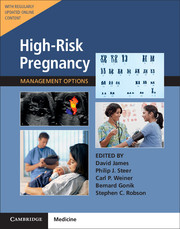Book contents
- Frontmatter
- Contents
- List of Contributors
- Preface
- Section 1 Prepregnancy Problems
- Section 2 Early Prenatal Problems
- Section 3 Late Prenatal – Fetal Problems
- Section 4 Problems Associated with Infection
- Section 5 Late Pregnancy – Maternal Problems
- Section 6 Late Prenatal – Obstetric Problems
- 52 Abdominal Pain in Pregnancy
- 53 Nonmalignant Gynecology in Pregnancy
- 54 Bleeding in Late Pregnancy
- 55 Multiple Pregnancy
- 56 Threatened and Actual Preterm Labor
- 57 Prelabor Rupture of the Membranes
- 58 Breech Presentation, Unstable Lie, Malpresentation, and Malpositions
- 59 Prolonged Pregnancy
- 60 Induction of Labor and Termination of the Previable Pregnancy
- 61 Dysfunctional Labor
- 62 Shoulder Dystocia
- 63 Fetal Compromise in Labor
- 64 Neuraxial Analgesia and Anesthesia in Obstetrics
- 65 Perineal Repair and Pelvic Floor Injury
- 66 Assisted Vaginal Delivery
- 67 Delivery After Previous Cesarean Section
- 68 Cesarean Section
- Section 7 Postnatal Problems
- Section 8 Normal Values
- Index
56 - Threatened and Actual Preterm Labor
from Section 6 - Late Prenatal – Obstetric Problems
- Frontmatter
- Contents
- List of Contributors
- Preface
- Section 1 Prepregnancy Problems
- Section 2 Early Prenatal Problems
- Section 3 Late Prenatal – Fetal Problems
- Section 4 Problems Associated with Infection
- Section 5 Late Pregnancy – Maternal Problems
- Section 6 Late Prenatal – Obstetric Problems
- 52 Abdominal Pain in Pregnancy
- 53 Nonmalignant Gynecology in Pregnancy
- 54 Bleeding in Late Pregnancy
- 55 Multiple Pregnancy
- 56 Threatened and Actual Preterm Labor
- 57 Prelabor Rupture of the Membranes
- 58 Breech Presentation, Unstable Lie, Malpresentation, and Malpositions
- 59 Prolonged Pregnancy
- 60 Induction of Labor and Termination of the Previable Pregnancy
- 61 Dysfunctional Labor
- 62 Shoulder Dystocia
- 63 Fetal Compromise in Labor
- 64 Neuraxial Analgesia and Anesthesia in Obstetrics
- 65 Perineal Repair and Pelvic Floor Injury
- 66 Assisted Vaginal Delivery
- 67 Delivery After Previous Cesarean Section
- 68 Cesarean Section
- Section 7 Postnatal Problems
- Section 8 Normal Values
- Index
Summary
Introduction
Despite the long-term focus on its prevention, preterm birth remains the leading cause of neonatal death, and the second leading cause of under-5 mortality, after pneumonia, worldwide. Of those babies who survive, many have severe long-term physical and neurodevelopmental morbidity. Management options for pregnant women with threatened preterm birth focus on delaying delivery using tocolysis, and administering antenatal therapy such as corticosteroids and, more recently, magnesium sulfate (for fetal lung development and neuroprotection respectively) to improve outcome for the infant once born. Given that most women who present with preterm contractions do not go on to deliver preterm infants, the challenge is to identify the appropriate recipients of these therapies.
Prevention of preterm birth relies on screening and identifying women at the highest risk of later preterm birth and using interventions such as cervical cerclage, progesterone therapy, or a cervical pessary while the woman is still asymptomatic. While traditionally based on prior obstetric history alone, both transvaginal cervical length and cervical fluid biomarkers, such as fetal fibronectin and phosphorylated insulin-like growth factor binding protein, are increasingly recognized as being useful for the prediction of preterm birth in both symptomatic and asymptomatic women. This chapter reviews the management of preterm labor and delivery, the screening tools available to identify women at high risk, and potential preventive interventions.
Summary of Terms
Preterm labor (PTL) is defined by the World Health Organization (WHO) as the onset of labor before 37 completed weeks or 259 days of gestation, and after the gestation of viability (22–28 weeks dependent on definition and setting). The onset of labor refers to regular uterine contractions (at least one every 10 minutes), associated with documented cervical change or rupture of fetal membranes. In the absence of cervical change or ruptured membranes, a diagnosis of threatened PTL (TPTL) can be made. Most women diagnosed with TPTL do not go on to deliver preterm.
Preterm birth (PTB) is the birth of an infant before 37 completed weeks’ gestation. The gestational endpoint of 37 weeks was decided upon by the WHO from a statistical analysis of the distribution of gestation of birth based on the first day of the last menstrual period.
- Type
- Chapter
- Information
- High-Risk Pregnancy: Management OptionsFive-Year Institutional Subscription with Online Updates, pp. 1624 - 1654Publisher: Cambridge University PressFirst published in: 2017
- 2
- Cited by

